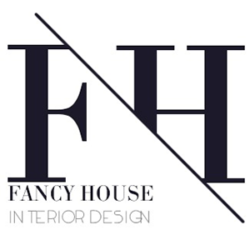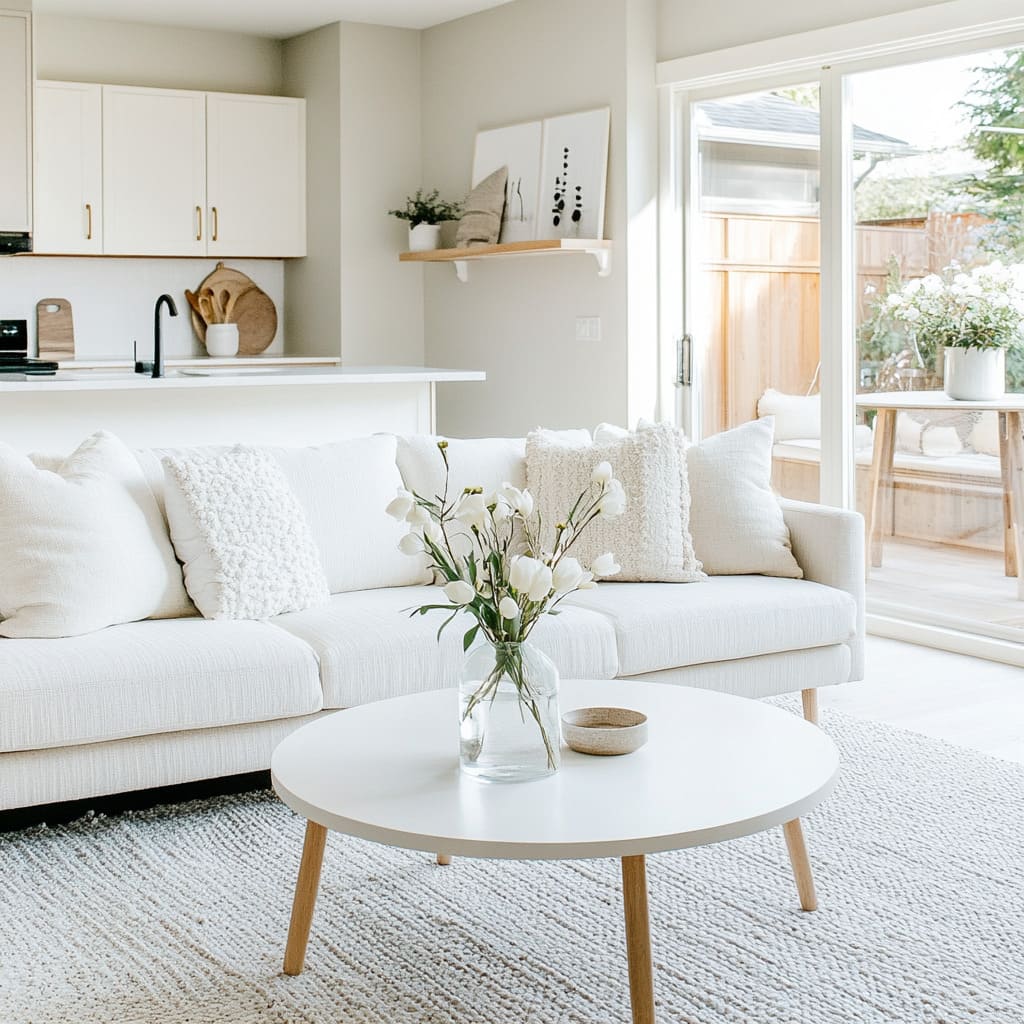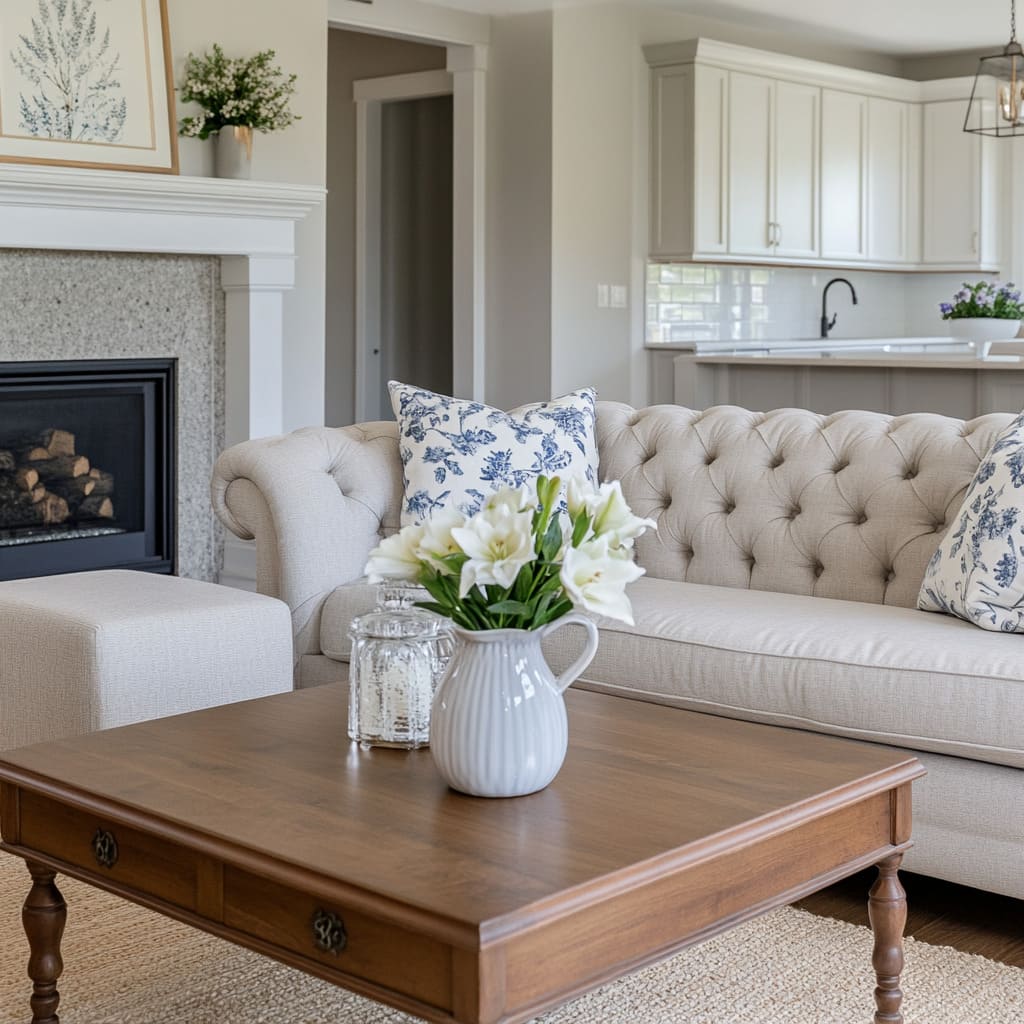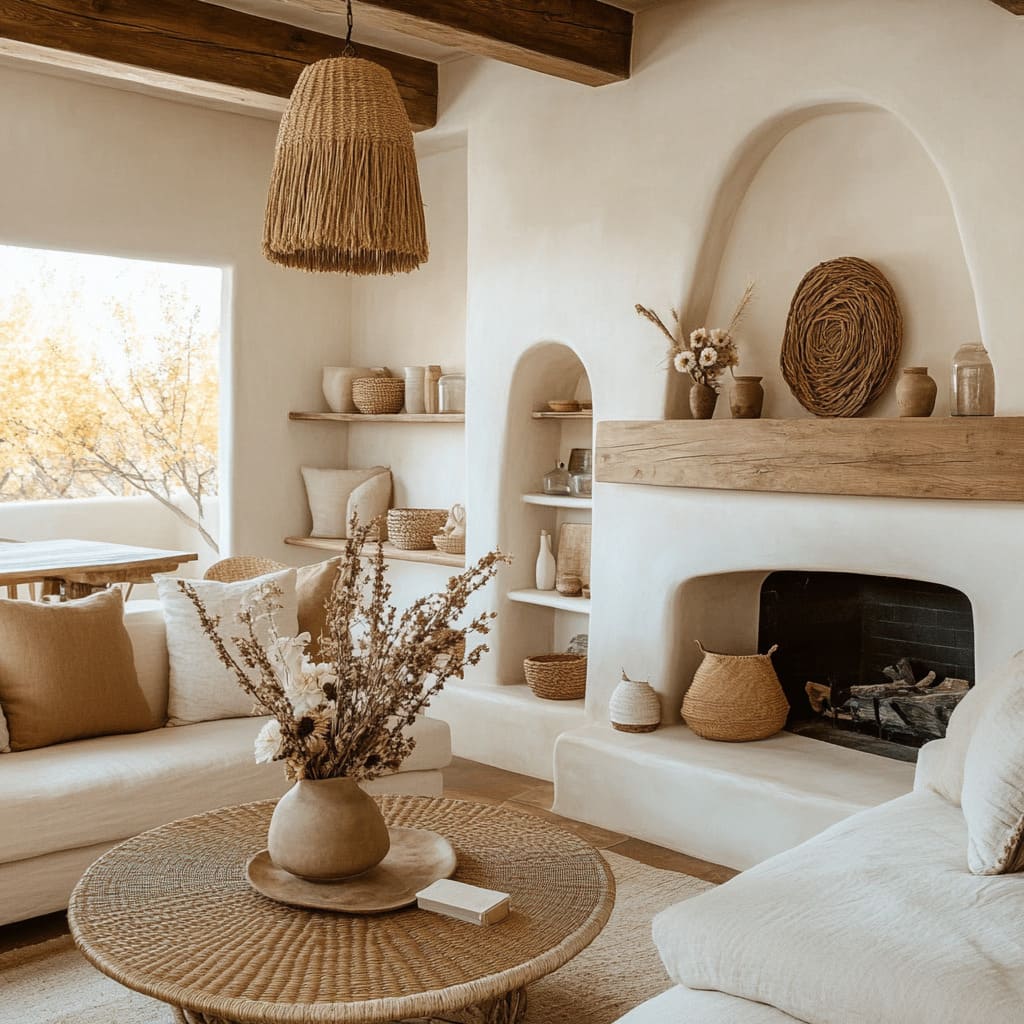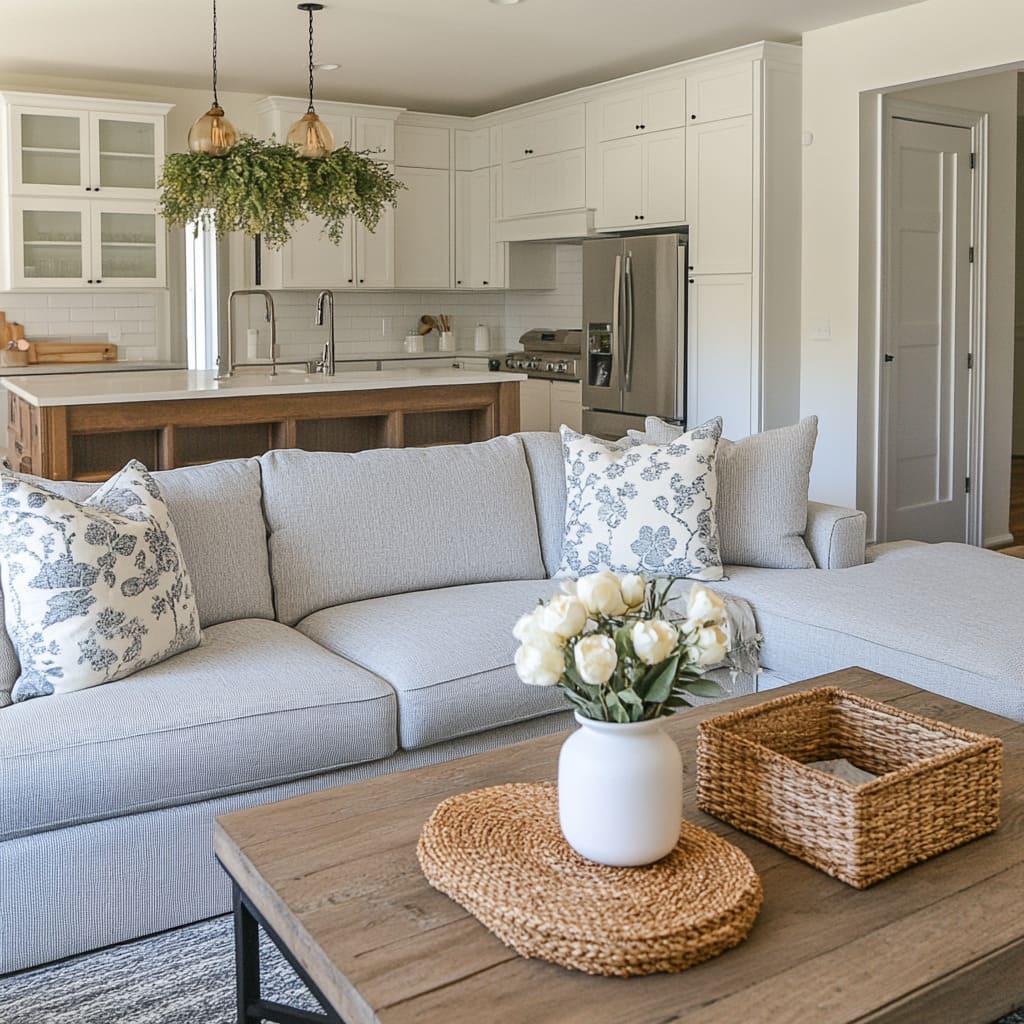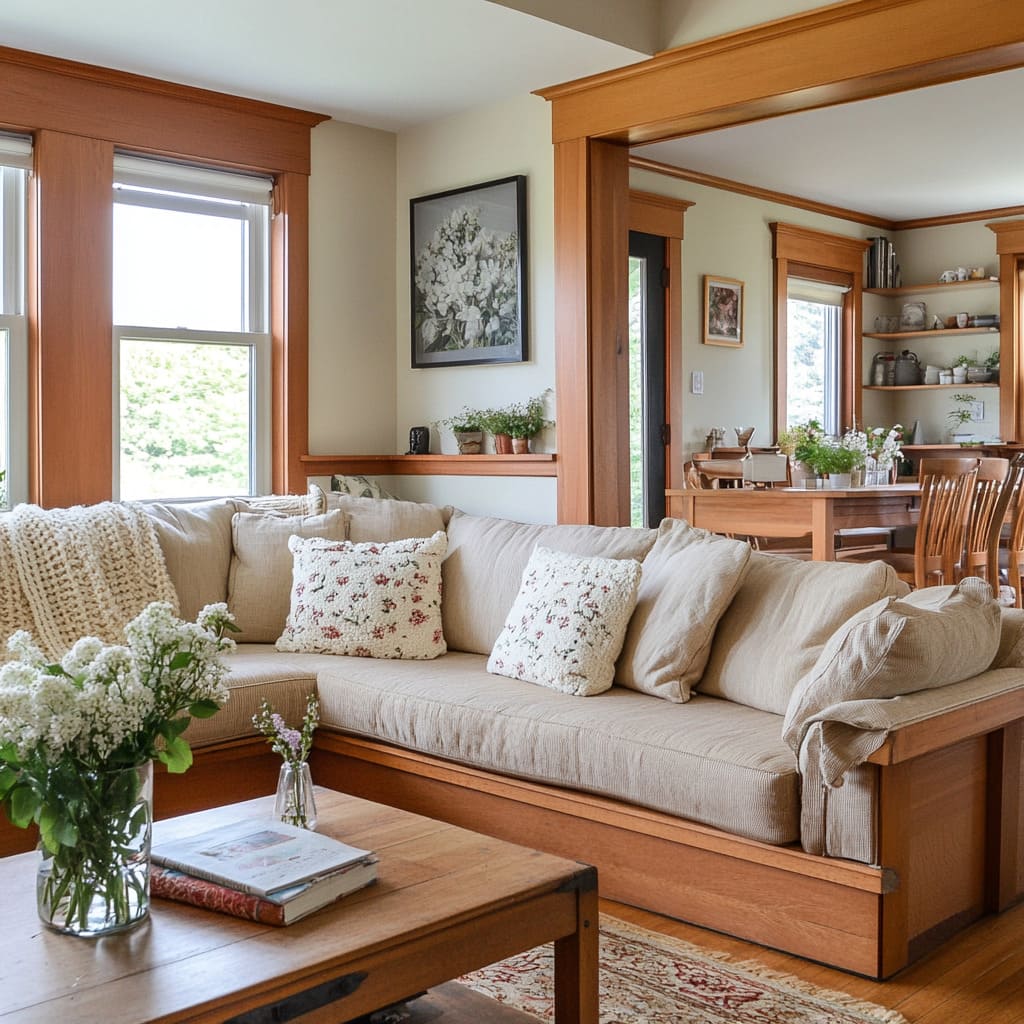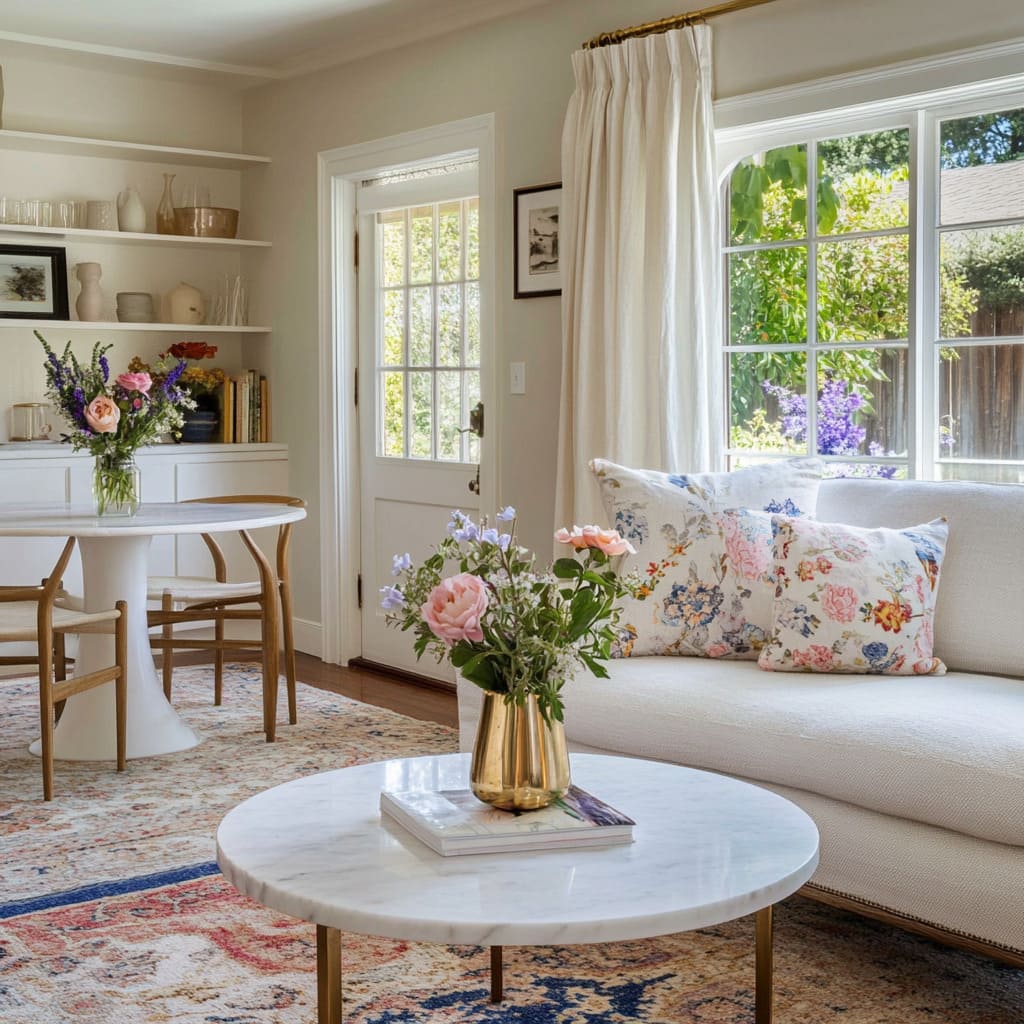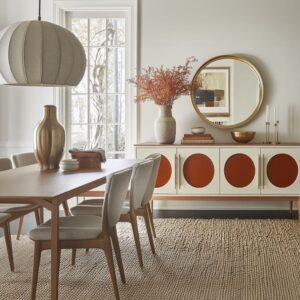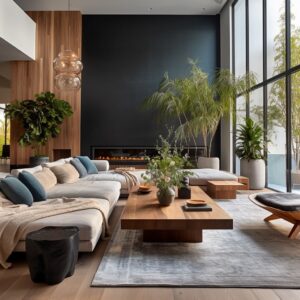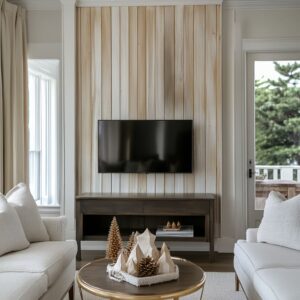Flowers in interior design go far beyond a simple vase on a table. Professional decorators use them as tools to shape the atmosphere of a space, highlight architectural details, and add layers of texture.
Whether creating a polished, structured look or a more relaxed, organic arrangement, the approach is always intentional. Every flower, from delicate baby’s breath to bold peonies, plays a role in the overall aesthetic.
Color choices influence mood, while placement can guide the eye toward key elements of a room. Mixing fresh and dried flowers, playing with different heights, and using unexpected containers can turn a floral display into a statement rather than an afterthought.
By understanding how decorators approach floral design, homeowners can bring the same level of detail into their own spaces. It’s all about using flowers with purpose—choosing the right blooms, placing them in a way that enhances the surroundings, and making sure they feel like an effortless extension of the room.
Flowers in Interior Design
Flowers do more than sit in a vase—they influence the way a space feels, looks, and even functions. Interior decorators use floral arrangements with purpose, whether to soften modern interiors, direct attention to key features, or set a mood that complements the room.
When chosen carefully, flowers become an essential part of home styling rather than just an afterthought.
Adding Movement to a Space
Interiors often rely on structured lines—straight furniture edges, symmetrical layouts, and fixed architectural details. Flowers introduce an organic element that breaks up this rigidity.
Soft petals, curving stems, and cascading greenery bring a sense of flow, making a space feel more inviting. This is especially useful in minimalist or contemporary settings where a touch of nature adds warmth without disrupting the clean aesthetic.
Creating Focal Points
A well-placed floral arrangement can guide the eye toward a specific area of a room. Whether it’s a bold centerpiece on a dining table, an arrangement on a mantel, or a statement piece on a console, flowers draw attention naturally.
They help balance out a space that might feel too empty or visually heavy in certain areas. For example, a large floral arrangement can ground an open-concept living room, while a simple bud vase on a bookshelf adds just enough interest to a quiet corner.
Enhancing the Mood
“Flowers are an easy way to pull in a pop of color. Whether you contrast a neutral space with a bolder hued bloom or stay within a monochromatic palette for understated sophistication, flowers immediately enhance the color scheme of any space” — Florist from MyGlobalFlowers International.
More than just decorative accents, flowers have a strong influence on the mood and energy of a home. Bright colors like yellow, orange, and red create an uplifting, social atmosphere, making them ideal for living rooms, dining areas, and kitchens.
In contrast, soft pastels such as blush pink, lavender, or light blue promote relaxation, which is why they work well in bedrooms and bathrooms. For a fresh and airy feel, white blooms with subtle greenery bring a sense of calm, making them perfect for spaces designed for unwinding.
Whether used as a statement piece or a subtle accent, the right floral colors can shape the personality of a room, creating a space that feels both balanced and inviting.
Framing Architectural Features
Decorators often use flowers to highlight parts of a room that deserve more attention. A floral arrangement placed near a window accentuates natural light, while a cascading vine on a staircase railing softens the structure.
Placing a floral display near an art piece or mirror creates a layered effect, drawing focus without overwhelming the main decor. Even small touches, like a single bloom near a sculptural object, can enhance its presence in a subtle yet effective way.
By thinking beyond traditional placements and selecting flowers based on their movement, color, and positioning, interior decorators create spaces that feel intentional and full of character. Flowers, when used with purpose, bring balance, softness, and vibrancy to any home.
Color Coordination: Going Beyond Matching Colors
Interior decorators, when choosing the right flowers for a space, think beyond basic color coordination, using flowers to create contrast, add depth, and keep a room feeling lively throughout the year.
Using Contrast and Complementary Colors
A room with a dominant color can feel flat without some contrast. This is where carefully chosen flowers can make a difference.
Instead of blending in, they can introduce an unexpected pop that enhances the overall look. For example:.
- A space with soft blue walls or furnishings feels more dynamic with warm-toned flowers like peach roses or golden marigolds.
- Neutral interiors with beige or gray tones come alive with bold florals like deep red dahlias or bright purple orchids.
- A room with dark furniture benefits from light-colored flowers such as white hydrangeas or pale pink tulips to create balance.
By using complementary colors, decorators ensure that floral arrangements don’t fade into the background but instead bring a space to life.
Layering Shades for a Sophisticated Look
Rather than using a single color, decorators often layer different tones within the same shade range. This approach gives arrangements depth and makes them look thoughtfully put together.
Some examples include:.
- A pink-toned arrangement mixing blush roses, dusty mauve ranunculus, and deep rose peonies for a soft, romantic effect.
- A green and white combination blending white lilies, pale green hydrangeas, and eucalyptus for a fresh, clean aesthetic.
- A warm, earthy mix featuring burnt orange tulips, terracotta-colored chrysanthemums, and deep red roses to add richness to neutral interiors.
Layering different shades prevents floral arrangements from looking flat and makes them feel more intentional.
Using Seasonal Colors for a Natural Touch
Keeping floral colors aligned with the season helps a home feel refreshed throughout the year. Seasonal flowers naturally blend with their surroundings, making them an effortless way to keep interiors feeling current.
- Spring: Soft pastels like pale yellow daffodils, lavender lilacs, and blush cherry blossoms add a light, airy feel.
- Summer: Bright hues such as coral peonies, sunflower yellow, and fuchsia dahlias bring energy to a space.
- Autumn: Warm, earthy tones with rust-colored mums, golden marigolds, and deep burgundy roses complement the season’s coziness.
- Winter: Crisp whites, rich reds, and soft greens, such as amaryllis, white roses, and pine sprigs, create a fresh yet cozy atmosphere.
By thinking beyond simple color matching and incorporating contrast, layered tones, and seasonal shifts, decorators use flowers to enhance a space in ways that feel natural yet visually interesting.
Unexpected Placement for Maximum Impact
Flowers don’t always have to sit in the middle of a dining table or rest on a sideboard. Interior decorators often find creative ways to place flowers in spots that feel more integrated into the design, making them feel like a natural extension of the space rather than just an accessory.
A thoughtful placement can completely shift the way a room feels, turning ordinary corners into lively, inviting areas.
Hanging Floral Installations Above Dining Tables
Instead of relying on traditional table centerpieces, decorators often look up—literally. Suspended floral arrangements bring a fresh perspective to dining areas, adding depth without cluttering the tabletop.
Whether it’s a delicate arrangement of trailing greenery and soft blooms or a statement piece with bold colors, this approach makes any dining space feel more inviting. Hanging floral pieces can also be adjusted seasonally, with fresh wildflowers in spring, dried arrangements in autumn, and evergreen branches in winter.
The key is keeping the installation light and airy so it enhances the room without overwhelming it.
Weaving Flowers Into Bookcases for a Natural Accent
Bookshelves aren’t just for books. Interior decorators often mix decorative objects into shelving, and flowers are a great way to add a bit of movement and life to the display.
Small floral arrangements tucked between books, draping vines cascading from the edges, or single blooms placed in tiny vases alongside decorative pieces add warmth and contrast to structured shelving. This works especially well in home offices or living rooms where a bookcase is a main focal point.
The combination of fresh elements with more structured decor creates a relaxed, inviting atmosphere.
Tucking Small Bud Vases Into Wall Niches
Wall niches, often overlooked, provide the perfect space for subtle floral touches. A single bud vase with a carefully selected bloom can add depth to a niche without making it feel crowded.
For a more artistic effect, decorators sometimes place a mix of small vases in different heights to create a layered look. This technique is especially useful in entryways or hallways, where there isn’t room for large arrangements but a small floral detail can still make an impact.
The simplicity of a single stem can be just as powerful as a full bouquet when placed thoughtfully.
Adorning Mirrors and Picture Frames with Floral Garlands
Adding flowers around mirrors or picture frames brings a soft, romantic effect to any room. Instead of just placing a vase on a dresser or vanity, decorators sometimes weave fresh or dried flowers into the edges of a mirror, creating a more immersive look.
For an airy and effortless feel, delicate garlands with smaller blooms work well. If the goal is something more dramatic, cascading greenery with statement flowers like roses or peonies can turn the frame into a decorative feature.
This approach works beautifully in bedrooms, dressing areas, or even above fireplaces for a seasonal touch. By stepping away from the usual placements and thinking of flowers as part of the home’s design, decorators create a setting where floral arrangements don’t feel like add-ons—they feel like they belong.
Using Scent to Influence Atmosphere
Flowers don’t just enhance a home visually—they also shape the way a space feels through scent. A carefully chosen floral fragrance can change the mood of a room, making it feel more inviting, refreshing, or calming.
Professional decorators often use scent as an extra layer of design, ensuring that flowers don’t just look beautiful but also create an atmosphere that suits the purpose of each space.
Soft Floral Scents for Bedrooms
A bedroom should feel like a retreat, and soft floral notes help set the right tone. Flowers like peonies, roses, and jasmine have a gentle yet lingering fragrance that promotes relaxation.
A small vase of fresh-cut blooms on a nightstand or dresser adds a light scent without overwhelming the room. For those who prefer a more subtle approach, dried flower sachets or scented floral water misted onto linens can provide a similar effect.
Placing jasmine vines near a window allows their fragrance to drift through the space naturally, enhancing the room’s peaceful feel.
Crisp Citrus Notes in Kitchens
A kitchen benefits from clean, refreshing scents that don’t interfere with food aromas. Lemon blossoms, orange blossoms, and even sprigs of fresh basil with small floral accents help maintain a fresh and uplifting environment.
A simple trick is to place a small vase with lemon or orange blossoms on a windowsill, where natural warmth will help release their scent throughout the day. Pairing them with rosemary or mint adds a herbal freshness that works especially well in a space where cooking takes center stage.
Lavender or Chamomile in Bathrooms for a Spa-Like Feel
Bathrooms are the perfect place for naturally calming scents. Lavender and chamomile bring a spa-like feel, making the space more inviting and relaxing.
Placing a small bundle of dried lavender near the sink or hanging a few sprigs in the shower allows the warm steam to gently release the scent, creating a soothing effect. Floating chamomile flowers in a decorative bowl of water can also add a soft fragrance while doubling as a delicate decor element.
By selecting flowers based on their scent, decorators ensure that fragrance works hand in hand with design, making each space feel intentional and more enjoyable to spend time in.
Choosing Vases as Design Elements
A floral arrangement is only as striking as the vase that holds it. While flowers bring life and color, the right vase helps tie them into the overall decor, making them feel like a natural part of the space rather than an afterthought.
Interior decorators carefully select vases based on style, material, and shape to enhance the arrangement while complementing the home’s aesthetic.
Minimalist Glass Cylinders for Modern Decor
For sleek, contemporary interiors, simple glass vases work best. Their clean lines and transparency let the flowers take center stage without adding visual clutter.
Tall cylindrical vases are perfect for structured arrangements like calla lilies or tulips, while shorter, rounder glass containers suit compact floral designs with peonies or hydrangeas. A single-stem approach in a slender glass vase also fits well in modern spaces, keeping the look refined without overwhelming the room.
Placing multiple identical vases with different flowers in a row on a dining table or console can create a subtle yet striking effect.
Ornate Ceramic Vases for Classic Styles
For homes with a more traditional aesthetic, ceramic vases with decorative details add a timeless touch. Hand-painted or embossed vases work beautifully with fuller floral arrangements, such as roses, lilacs, or hydrangeas.
Their weight also makes them ideal for supporting larger bouquets, preventing them from toppling over. Blue and white porcelain vases, inspired by vintage European and Asian designs, pair well with delicate blooms like cherry blossoms or lavender.
For a more formal setting, urn-style vases can elevate the look of an entryway or dining room centerpiece.
Rustic Terracotta Pots for Farmhouse Aesthetics
Homes with a warm, casual feel benefit from textured, earthy materials. Terracotta pots, aged clay vases, and stoneware containers bring a natural quality to floral displays.
These vases work well with wildflowers, sunflowers, and eucalyptus, emphasizing a relaxed and inviting atmosphere. For an extra rustic effect, decorators sometimes pair dried flowers with these vases, allowing their muted tones to complement the warm hues of the material.
A set of different-sized clay vases grouped together on a mantel or shelf can create a cozy, layered look.
Asymmetrical or Sculptural Vases for a Contemporary Look
Modern interiors with an artistic edge benefit from vases that feel more like sculptures than traditional containers. Asymmetrical designs, organic curves, and geometric shapes add a dynamic touch to floral arrangements.
These vases pair well with exotic or structural flowers, such as proteas, anthuriums, or orchids, enhancing their striking appearance. Bold, oversized vases with unique silhouettes can act as standalone decor pieces, even without flowers.
Neutral-toned sculptural vases blend well with minimalist decor, while brightly colored ceramic or resin vases can make a statement in more eclectic spaces. By treating vases as part of the design rather than just a container, decorators ensure that flowers don’t just bring life to a room—they also add character and style.
Layering Floral Decor with Other Natural Elements
Flowers bring color and movement to a space, but when combined with other natural materials, they create a richer, more dimensional look. Interior decorators often mix floral arrangements with textures like stone, wood, and woven fibers to give rooms a balanced, organic feel.
Whether styling a dining table, console, or coffee table, layering different materials alongside flowers makes the design feel intentional and visually interesting.
Placing Flowers Near Candles to Enhance Ambiance
Soft candlelight already adds warmth to a space, but pairing it with fresh flowers amplifies the effect. A few well-placed blooms around a cluster of pillar candles or a floating floral arrangement in a shallow dish with tea lights creates a subtle, romantic glow.
For a more structured look, decorators often place small floral arrangements in glass hurricanes with candles, allowing the light to reflect off the petals. This technique works well on dining tables, fireplace mantels, or bedside tables, where the flickering glow can interact with the floral arrangement, enhancing both elements.
Combining Flowers with Fruit in Bowls for Dynamic Texture
Fresh flowers and fruit create a visually striking combination that feels natural and vibrant. This approach is often seen in European-inspired interiors, where bowls of citrus, figs, or pomegranates sit alongside floral centerpieces on kitchen islands or dining tables.
Matching fruit to the floral arrangement enhances the overall effect. Lemons or oranges pair well with white flowers like peonies or hydrangeas, while deep-colored fruit like plums or grapes complement richer-toned flowers like dahlias or ranunculus.
This layering technique not only adds texture but also brings in a subtle connection to nature.
Mixing Flowers with Driftwood, Stones, or Woven Baskets for a Natural, Grounded Look
Florals feel even more connected to their surroundings when combined with elements from nature. A sculptural piece of driftwood on a coffee table with a loose floral arrangement nearby creates a balance between structure and softness.
Smooth stones or pebbles added to clear vases anchor the flowers and introduce an extra layer of texture. In rustic or bohemian interiors, woven baskets work well as unexpected floral containers.
A large, handwoven basket filled with wildflowers or dried botanicals makes an eye-catching statement, especially in entryways or living rooms. The rough texture of natural fibers complements the delicate petals, making the floral arrangement feel more grounded in the space.
By blending flowers with other natural materials, decorators create arrangements that feel effortlessly connected to their surroundings. Whether using soft candlelight, fresh fruit, or organic textures, layering floral decor makes a home feel both curated and inviting.
Conclusion
Fresh flowers have a way of making a home feel more alive, adding texture, color, and a natural rhythm to any space. Whether used in bold arrangements, subtle accents, or layered with other decor, they bring something no other element can match.
By thinking beyond the usual placements and choosing flowers with purpose—considering seasonality, scent, and how they interact with other materials—it’s easy to create an atmosphere that feels both effortless and intentional. The beauty of floral decor is its flexibility.
A single stem in a sculptural vase can make as much of an impact as a cascading centerpiece, and small touches, like flowers tucked into bookshelves or woven through mirrors, can completely shift the feel of a room. Whether aiming for a polished arrangement or a loose, organic look, flowers adapt to any style, adding a fresh, welcoming energy.
With the right choices, floral decor doesn’t just fill space—it shapes it, making a home feel more inviting and connected to nature.
